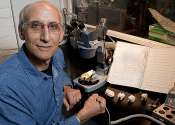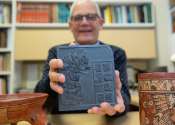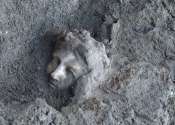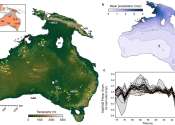Last update:
Archaeology news

Recreating the face of a 75,000-year-old female from a cave where Neanderthals buried their dead
A new Netflix documentary has recreated the face of a 75,000-year-old female Neanderthal whose flattened skull was discovered and rebuilt from hundreds of bone fragments by a team of archaeologists and conservators led by ...
Archaeology
8 hours ago
0
9

Revised dating of the Liujiang skeleton renews understanding of human occupation of China
The emergence of Homo sapiens in Eastern Asia has long been a subject of intense research interest, with the scarcity of well-preserved and dated human fossils posing significant challenges.
Archaeology
18 hours ago
0
98

Scientists show that ancient village adapted to drought, rising seas
Around 6,200 BCE, the climate changed. Global temperatures dropped, sea levels rose and the southern Levant, including modern-day Israel, the Palestinian territories, Jordan, Lebanon, southern Syria and the Sinai desert, ...
Archaeology
Apr 30, 2024
0
181

Significant differences among nordic regions during the Bronze Age
The Scandinavian Bronze Age—despite a unifying material culture—was complex with constantly changing networks involving both competitors and collaborators. In a new book by archaeologists from the University of Gothenburg ...
Archaeology
Apr 30, 2024
0
96

Archaeology team discovers a 7,000-year-old settlement in Serbia
Together with cooperation partners from the Museum of Vojvodina in Novi Sad (Serbia), the National Museum Zrenjanin and the National Museum Pančevo, a team from the ROOTS Cluster of Excellence has discovered a previously ...
Archaeology
Apr 30, 2024
0
330

Tibetan plateau had broader social dimensions than previously thought, suggests study
The Tibetan plateau—the world's highest and largest plateau—poses a challenge to the people who live there because of its extreme climate. In a new study, researchers have discovered stone artifacts that suggest that ...
Archaeology
Apr 29, 2024
0
139

Underwater cultural heritage: Studying 'orphaned objects' to work out which shipwrecks they came from
A lot of the recent talk about maritime issues in Southeast Asia has focused on issues such as security, the Blue Economy, law enforcement and climate change. But there's one maritime challenge that's gone underdiscussed: ...
Archaeology
Apr 29, 2024
0
29

Isotopic evidence reveals surprising dietary practices of ancient hunter-gatherers
It has long been thought that meat played an important role in the diet of hunter-gatherers before the Neolithic transition. However, due to the scarcity of well-preserved human remains from Paleolithic sites, little information ...
Archaeology
Apr 29, 2024
0
66

Prehistoric Irish monuments may have been pathways for the dead
Archaeologists have used advanced lidar technology to discover hundreds of monuments in the famous prehistoric landscape of Baltinglass, Ireland, revealing insights into the ritual activities of the farming communities that ...
Archaeology
Apr 29, 2024
0
30

DNA study of Avar cemetery remains reveals network of large pedigrees and social practices
An international team of archaeologists and archaeogenetics specialists, working with the Hungarian National Museum, has discovered a network of Avar pedigrees and community social practices after conducting a DNA study of ...

Ancient Maya blessed their ballcourts: Researchers find evidence of ceremonial offerings in Mexico
For sports fans, places like Fenway Park, Wembley Stadium or Wimbledon's Centre Court are practically hallowed ground.
Archaeology
Apr 27, 2024
1
239

Did Vesuvius bury the home of the first Roman emperor?
A group of archaeologists, led by researchers from the University of Tokyo, announce the discovery of a part of a Roman villa built before the middle of the first century. This villa, near the town of Nola in southwestern ...
Archaeology
Apr 26, 2024
0
49

Researchers reconstruct landscapes that greeted the first humans in Australia around 65,000 years ago
Seventy thousand years ago, the sea level was much lower than today. Australia, along with New Guinea and Tasmania, formed a connected landmass known as Sahul. Around this time—approximately 65,000 years ago—the first ...
Archaeology
Apr 26, 2024
0
2536

New rock art discoveries in Eastern Sudan tell a tale of ancient cattle, the 'green Sahara' and climate catastrophe
The hyper-arid desert of Eastern Sudan, the Atbai Desert, seems like an unlikely place to find evidence of ancient cattle herders. But in this dry environment, my new research has found rock art over 4,000 years old that ...
Archaeology
Apr 26, 2024
0
61

Gender-nonconforming ancient Romans found refuge in community dedicated to goddess Cybele
A Vatican declaration, the "Infinite Dignity," has brought renewed attention to how religions define and interpret gender and gender roles.
Archaeology
Apr 25, 2024
0
108

Archaeologists unearth top half of statue of Ramesses II
A team co-led by a CU Boulder classics researcher has unearthed the upper portion of a huge, ancient pharaonic statue whose lower half was discovered in 1930; Ramesses II was immortalized in Percy Bysshe Shelly's "Ozymandias."
Archaeology
Apr 25, 2024
0
55

The story of the first Alor people adapting to climate change 43,000 years ago
As humans, our greatest evolutionary advantage has always been our ability to adapt and innovate. When people first reached the expanded coastline of Southeast Asia around 65,000 years ago, and faced the sea crossings necessary ...
Archaeology
Apr 24, 2024
0
9

Social change may explain decline in genetic diversity of the Y chromosome at the end of the Neolithic period
The emergence in the Neolithic of patrilineal social systems, in which children are affiliated with their father's lineage, may explain a spectacular decline in the genetic diversity of the Y chromosome observed worldwide ...
Archaeology
Apr 24, 2024
0
44

Scientists use ancient DNA, historical context to unravel kinship, social practices of Avar society
A multidisciplinary research team led by scientists at the Max Planck Institute for Evolutionary Anthropology has combined ancient DNA data with a clear archaeological, anthropological and historical context to reconstruct ...
Archaeology
Apr 24, 2024
0
30

Stonehenge may have aligned with the moon as well as the sun
When it comes to its connection to the sky, Stonehenge is best known for its solar alignments. Every midsummer's night tens of thousands of people gather at Stonehenge to celebrate and witness the rising sun in alignment ...
Archaeology
Apr 22, 2024
0
77
Other news

Twisting and binding matter waves with photons in a cavity

Mystery behind huge opening in Antarctic sea ice solved

This Texas veterinarian helped crack the mystery of bird flu in cows

New work reveals the 'quantumness' of gravity

Researchers discover key functions of therapeutically promising jumbo viruses

Marine sharks and rays 'use' urea to delay reproduction, finds study

Satellite images of plants' fluorescence can predict crop yields

Religious intolerance predicts science denial, surveys suggest

Researchers create new chemical compound to solve 120-year-old problem

Study: Airway hillocks challenge our understanding of lung biology

Physicists discover new way to make strange metal

Why you can taste more ethanol in a cold pint of beer or warm glass of baijiu















































